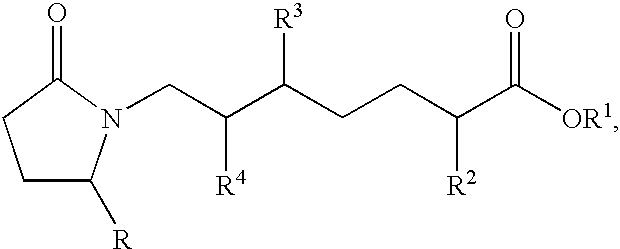EP4 receptor selective agonists in the treatment of osteoporosis
a prostaglandin and ep4 receptor technology, applied in the direction of biocide, heterocyclic compound active ingredients, drug compositions, etc., can solve the problems of estrogen not restoring bone back to young adult levels in the established osteoporotic skeleton, the risk of osteoporosis is the greatest among the elderly, and the risk is predicted to increase significantly
- Summary
- Abstract
- Description
- Claims
- Application Information
AI Technical Summary
Problems solved by technology
Method used
Image
Examples
example 1b
4-(3-{2-[3-Hydroxy-4-(3-trifluoromethyl-phenyl)-butyl]-5-oxo-pyrrolidin-1-yl}-propyl)-benzoic acid
Step A: 5-[3-Oxo-4-(3-trifluoromethyl-phenyl)-butyl]-pyrrolidin-2-one Magnesium coils (1.13 g) were stirred under vacuum in a round bottom flask for 60 h. Anhydrous Et.sub.2 O (5 mL) was added and the reaction mixture was cooled to 0.degree. C. A solution of 3-trifluoromethylbenzyl chloride (1.0 mL, 7.5 mmol) in Et.sub.2 O (25 mL) was added dropwise over 3 h. The reaction mixture was stirred for an additional 2.5 h. The solution was slowly added via a syringe and filtered through a Nylon Acrodisc.TM. syringe filter into a solution of tetrahydro-pyrrolizine-3,5-dione (650 mg, 4.68 mmol) in CH.sub.2 Cl.sub.2 (30 mL) at 0.degree. C. After 2 h, the reaction mixture was quenched with 1 N HCl and the aqueous solution was washed with CH.sub.2 Cl.sub.2 (2.times.). The organic solutions were combined, dried (MgSO.sub.4), filtered and concentrated. Medium pressure chromatography (1:1 hexanes:EtOA...
example 1c
4-(3-{2-[4-(3-Chloro-phenyl)-3-hydroxy-butyl]-5-oxo-pyrrolidin-1-yl}-propyl)-benzoic acid
Step A: 5-[4-(3-Chloro-phenyl)-3-oxo-butyl]-pyrrolidin-2-one. Analogous to the procedure described for Example 1A, Step A, tetrahydro-pyrrolizine-3,5-dione (2 g, 14 mmol) was reacted with 3-chlorobenzylmagnesium chloride (0.25M in Et.sub.2 O, 62 mL, 15.5 mmol) over 2 h. Purification by medium pressure chromatography eluting with a solvent gradient (2:1 hexanes:EtOAc to EtOAc to 5% MeOH in CH.sub.2 Cl.sub.2) provided 5-[4-(3-chloro-phenyl)-3-oxo-butyl]-pyrrolidin-2-one (1.9142 g). .sup.1 H NMR (CDCl.sub.3) .delta.7.27 (m, 2H), 7.19 (m, 1H), 7.08 (m, 1H), 6.27 (br, 1H), 3.68 (s, 2H), 3.60 (m, 1H), 2.52 (t, 2H), 2.29 (m, 2H), 2.21 (m, 1H), 1.88-1.60 (m, 3H); MS 266.2 (M+1), 264.2 (M-1).
Step B: 5-[4-(3-Chloro-phenyl)-3-hydroxy-butyl]-pyrrolidin-2-one. Analogous to the procedure described for Example 1A, Step B, 5-[4-(3-chloro-phenyl)-3-oxo-butyl]-pyrrolidin-2-one (1.9 g, 7.15 mmol) was reduced with ...
example 1d
4-(3-{2-[4-(3-Fluoro-phenyl)-3-hydroxy-butyl]-5-oxo-pyrrolidin-1-yl}-propyl)-benzoic acid
Step A: 5-[4-(3-Fluoro-phenyl)-3-oxo-butyl]-pyrrolidin-2-one. Analogous to the procedure described for Example 1A, Step A, tetrahydro-pyrrolizine-3,5-dione (2 g, 14 mmol) was reacted with 3-fluorobenzylmagnesium chloride (0.25M in Et.sub.2 O, 62 mL, 15.5 mmol) over 2.5 h. Purification by medium pressure chromatography using a solvent gradient (1:1 hexanes:EtOAc to 2:1 EtOAc:hexanes to EtOAc to 2% MeOH in CH.sub.2 Cl.sub.2 to 10% MeOH in CH.sub.2 Cl.sub.2) provided 5-[4-(3-fluoro-phenyl)-3-oxo-butyl]-pyrrolidin-2-one (2.1730 g). .sup.1 H NMR (CDCl.sub.3) .delta.7.32-7.27 (m, 1H), 7.00-6.90 (m, 3H), 6.12 (bs, 1H), 3.69 (s, 2H), 3.59 (m, 1H), 2.52 (t, 2H), 2.30 (m, 2H), 2.19 (m, 1H), 1.75 (m, 2H), 1.65 (m, 1H).
Step B: 5-[4-(3-Fluoro-phenyl)-3-hydroxy-butyl]-pyrrolidin-2-one. Analogous to the procedure described for Example 1A, Step B, 5-[4-(3-fluoro-phenyl)-3-oxo-butyl]-pyrrolidin-2-one (2.17 g, 8....
PUM
 Login to View More
Login to View More Abstract
Description
Claims
Application Information
 Login to View More
Login to View More - R&D
- Intellectual Property
- Life Sciences
- Materials
- Tech Scout
- Unparalleled Data Quality
- Higher Quality Content
- 60% Fewer Hallucinations
Browse by: Latest US Patents, China's latest patents, Technical Efficacy Thesaurus, Application Domain, Technology Topic, Popular Technical Reports.
© 2025 PatSnap. All rights reserved.Legal|Privacy policy|Modern Slavery Act Transparency Statement|Sitemap|About US| Contact US: help@patsnap.com



